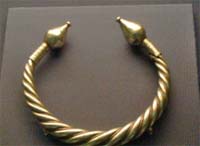|
2. Confraternities
The silversmith guilds witnessed a time of splendour from mid 16th century to mid 17th century. They then gradually loosened their severe professional and religious norms, until it became necessary to try and recover the old spirit. On September 27, 1809, the silversmith schools were temporarily extinct, as were other brotherhoods and congregations established in the convents. On March 31 1842, the King Regent abolished all these practices and the silver trade and industry became deregulated.
The Chapters

At the chapel of the holy Patron, the silversmiths celebrated four general chapters a year. Only guild masters could attend and no arms were allowed. The masters who failed to attend were obliged to pay a fine. The chapters started with a mass for the Patron, presided by the Elder Father, together with two of the mayors or weighers and two official guardians, chosen from those who had presented great expertise in the Art and those who were the most ardent supporters of the common good. These were yearly positions elected at the chapter of Saint Eloy's Day, with their mandate starting at Christmas. The nominees had to be "wise, of good life, and god-fearing". They swore to be loyal to their posts and the brothers promised to obey them. During those chapters, attendants could vote for the modification of the rules and the status of the guild.
At the end of the 18th century the chapters had to have tools and instruments, which were used by the guilds to mould, empty, cut, carve and adorn the metal. The guilds handed out alms to the orphans and widows of guild members and paid the burial costs of poor silversmiths. Fines were charged if fellow members did not bring candles to the burial or prayer sessions of their brothers.
Admission to the guild
The aspiring silversmith had to formally solicit admission in writing, justifying his abilities and listing his merits, which the master of the workshop he worked had to confirm. The aspiring silversmiths could not be renegades, or have a bad reputation or indulge in sinful pursuits outside of wedlock. In order to be considered the silversmith, had to pay a certain amount of money towards charitable causes.
The aspiring master attended the presentation act before the Silversmith Chapter and swore before them to defend the purity of the Holy Mary. Later, in his absence the Chapter voted on his admission or rejection to the guild.
Duties of the Board of Governors
The rectors of the Guild of Silversmiths presided over the Chapter, carried out examinations, authorised shops and complied with the pious and charitable dispositions of good governance. They also weighed the gold carats and fixed the value of silver and established the true way and precise order in which precious metals were to be crafted. Finally they exposed any deceitful schemes related to precious metals and made sure that the masters and apprentices were honest people which had to have the characteristics of long standing Christians, free of any impurity of blood, of proper ascendance and of their parents. They finally awarded a price to the best silver master.
The rectors also ensured the law was respected and denounced any breach of law they witnessed. They visited the silversmith workshops and shops to check the weights and to confiscate any faulty pieces.

At times of scarcity of precious metals, they inspect silversmiths and craftsmen to ensure that they did not obtain them by melting coins of legal tender. The worked silver they acquired was not to be melted before three days had passed, to give people the chance to buy it by weight. All pieces were required to carry the marks of the master and the city it originated from.
The creations could not be sold in distant or inaccessible places, so as to ensure they could be easily controlled. Clandestine sale of jewellery was forbidden, as it often came from robberies and acts of sacrilege. The Board of Governors of the Guild also monitored the market to ensure no fake pieces were sold.
In the mid 18th century, an enormous quantity of attractive and very reasonably priced jewels arrived to Spain from abroad. These jewels had been made mechanically, using false precious stones and very low quality of silver. It was then considered necessary to take preventive measures. Laws were therefore issued against the importation of these objects as well as for the surveillance of the harbours and frontiers and the prohibition of selling jewellery to foreigners.
The leaders of the Guild kept the rich ornaments and sacred objects belonging to the congregation in custody, under inventory. The sacred objects were generally made up from donations of the brothers as well as confiscations for not having complied with the legal requirements. In an arc with two keys -one kept by the elder brother and the other by a veedor (guardian)- they kept the marks of all the silversmiths printed in lead, which had to be registered before the Council Scribe; and the archive of the Guild, which had the following books: Book of Decrees, Book of Chapter Minutes, Book of Accounts of the Major-domo, List of the silversmith brothers, List of masters and apprentices, Book of receipts of the brothers, Books of exam drawings, Books of exam and shop licences, Book of deaths and burials, Book of maids of the brotherhood, and Book of Inspection Visits. The guild mayors kept the latter.
|
